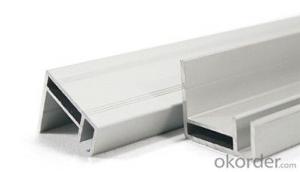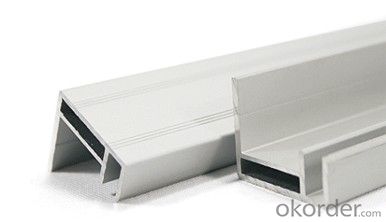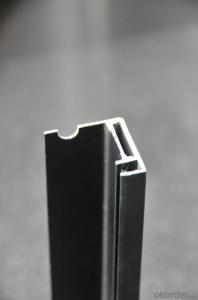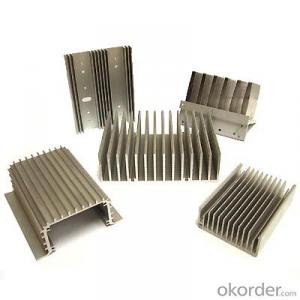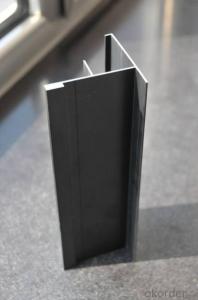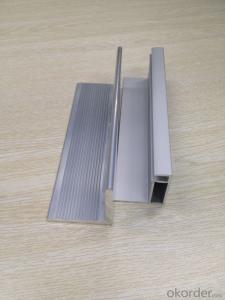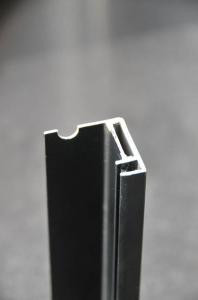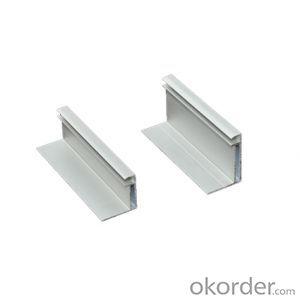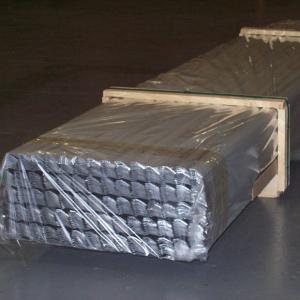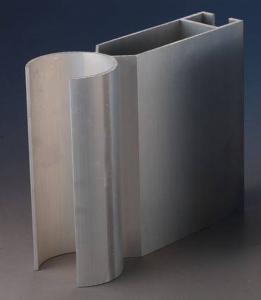Aluminum Strut Profiles Solar Module Aluminum Frame
OKorder Service Pledge
OKorder Financial Service
You Might Also Like
We are the largest aluminum profilemanufacture in
Provide full type of solar module frame:
Size:30x25mm
35x35mm
35x40mm
Other size can be accepted.
Material | Alloy Aluminum 6063,6061,6005,6082 or customer nominated |
Temper | T3, T4, T5, T6 and other |
Surface | Anodize, electrophoresis, powder coating, PVDF coating, wood grain painting, etc. |
Colour | Any colour based on Standard Germany RAL Mark |
Length | Not more than 16 meters |
Good Package | Inner plastic film /outside carton/wooden pallets |
Payment Method | T/T, L/C, etc |
Delivery Time | Normally 2-4 weeks, Delivery time can be consulted. |
Press Machine | 500-12500 tons all together 93 press lines. |
Fabrication | 1. Solar module frame; 2. Drilling; 3. Bending; 4. Cutting; 5. etc. |
Certificate | ISO/TS 16949,DNV,IRIS,CCS,AFA,etc. |
Dies | 1. Using our dies, no fee; |
2. Using customer drawing, opening dies, usually about 5~50 tons then the dies cost can be refunded. | |
3. Die cost is negotiable base on the order quantity | |
Capability | Annual output 800,000 tons |
- Q: How do you prevent galvanic corrosion when combining aluminum profiles with concrete or masonry?
- One effective method to prevent galvanic corrosion when combining aluminum profiles with concrete or masonry is to use a protective barrier. Applying a suitable coating or corrosion-resistant material on the aluminum surface can create a barrier between the aluminum and the concrete/masonry, preventing direct contact and minimizing the risk of galvanic corrosion. Additionally, using isolation materials such as gaskets or non-conductive joint fillers between the aluminum profiles and the concrete/masonry can further help to prevent galvanic corrosion by isolating the dissimilar metals. Regular inspection and maintenance are also essential to identify any potential corrosion issues early on and take necessary preventive measures.
- Q: Are aluminum profiles suitable for partition walls?
- Yes, aluminum profiles are suitable for partition walls. They are lightweight, durable, and offer excellent structural support. Additionally, aluminum profiles are easy to install, maintain, and can be customized to fit different design requirements. They also provide good thermal and sound insulation properties, making them a popular choice for partition walls in various settings such as offices, homes, and commercial spaces.
- Q: How do you prevent discoloration or fading of aluminum profiles?
- There are several steps that can be taken to prevent discoloration or fading of aluminum profiles: 1. It is crucial to clean aluminum profiles regularly in order to eliminate any dirt, dust, or contaminants that may cause discoloration or fading. This can be accomplished by using a mild detergent or a specialized aluminum cleaner, followed by rinsing with clean water. 2. Avoid using harsh or abrasive cleaners that can harm the surface of aluminum profiles, resulting in discoloration or fading. It is important to utilize gentle cleaning products specifically designed for aluminum. 3. Applying a protective coating to the surface of aluminum profiles can help prevent discoloration and fading. There are various types of coatings available, such as clear coats or anodizing, which create a protective barrier against environmental factors. 4. Protect aluminum profiles from prolonged exposure to harsh elements, such as direct sunlight, extreme temperatures, or chemicals. These factors can accelerate the process of discoloration or fading. If the profiles are installed outdoors, consider providing sufficient shading or protective covers to minimize exposure. 5. Regularly inspect and maintain aluminum profiles to identify any early signs of discoloration or fading. Promptly addressing any issues, such as scratches or surface damage, can prevent further deterioration. 6. If aluminum profiles are not immediately installed, it is important to store them in a dry and well-ventilated area, away from moisture or direct sunlight. Proper storage can help preserve the integrity of the profiles and prevent premature discoloration or fading. By following these preventive measures, it is possible to extend the lifespan and maintain the aesthetic appeal of aluminum profiles, reducing the risk of discoloration or fading.
- Q: This question asks for methods to prevent aluminum profiles from rusting during the storage and transportation phases.
- <p>To prevent rusting of aluminum profiles during storage and transportation, follow these steps: 1. Keep the profiles dry and clean, avoiding contact with moisture and corrosive substances. 2. Store them in a cool, dry place, away from direct sunlight and heat sources. 3. Use protective packaging, such as plastic wrapping or anti-corrosion paper, to shield the profiles from moisture and contaminants. 4. Ensure proper ventilation in storage areas to prevent condensation. 5. Avoid stacking profiles directly on the ground; use pallets or racks to elevate them and allow air circulation. 6. Regularly inspect the profiles for signs of corrosion and address any issues promptly. By implementing these measures, you can significantly reduce the risk of rusting during storage and transportation.</p>
- Q: This question asks for a method to determine the quantity of aluminum profiles required for a construction project.
- <p>To calculate the amount of aluminum profiles needed for a building project, follow these steps: 1. Determine the design specifications and dimensions of the project, including the length, width, and height of the structure. 2. Identify the types and sizes of aluminum profiles required based on the structural needs and design. 3. Calculate the total linear footage of each profile type needed by multiplying the length of each required section by the number of sections. 4. Add up the total linear footage for all profile types. 5. Account for waste and cutting losses, typically adding 5-10% to the total. 6. Ensure the calculations comply with building codes and safety standards. Consult with engineers or architects if necessary.</p>
- Q: This question asks about the various types of fastening mechanisms used to attach exterior walls to the structural frames of buildings.
- <p>Different types of fasteners used to secure exterior walls to building frames include nails, screws, bolts, and anchors. Nails are commonly used for wood-framed structures, while screws offer greater holding power. Bolts are used in steel or concrete structures and can be either through-bolts or expansion bolts. Anchors, such as masonry or concrete anchors, are used for securing to masonry or concrete walls. Additionally, adhesives and mechanical fasteners like clips and brackets are also used depending on the material and design of the exterior wall and building frame.</p>
- Q: This question asks for the method to determine the quantity of aluminum profiles required for a construction project.
- <p>To calculate the amount of aluminum profiles needed for a building project, follow these steps: 1. Determine the architectural design and specifications of the project to understand where aluminum profiles will be used. 2. Measure the dimensions of the areas requiring aluminum profiles, such as window frames, door frames, or structural supports. 3. Calculate the total linear footage of aluminum needed by multiplying the length of each profile by the number of profiles required. 4. Factor in additional materials for joints, connections, and potential waste. 5. Consult with suppliers or use industry-standard conversion factors to determine the weight or volume of aluminum profiles based on the linear footage. 6. Review the calculations and adjust for any changes in the project design. This process ensures you have the correct amount of aluminum profiles for your construction needs.</p>
- Q: This question asks for an overview of the various types of aluminum profiles that are frequently utilized in the field of commercial construction.
- <p>Commonly used aluminum profiles in commercial construction include: 1. Extruded aluminum profiles, which are versatile and can be customized for various applications. 2. Structural aluminum framing, used for building structures and curtain walls. 3. Aluminum window and door frames, known for their durability and energy efficiency. 4. Aluminum handrails and railings, important for safety in commercial buildings. 5. Aluminum trusses, used for roof structures and large spans. 6. Aluminum angles and channels, used for support and framing. 7. Aluminum tubes, used in various structural and decorative applications. These profiles are chosen for their strength, lightweight, corrosion resistance, and ease of maintenance.</p>
- Q: Are aluminum profiles suitable for electrical grounding applications?
- Yes, aluminum profiles are suitable for electrical grounding applications. Aluminum is a highly conductive material that allows for efficient flow of electrical current, making it an ideal choice for grounding systems. Additionally, aluminum profiles offer excellent corrosion resistance, durability, and cost-effectiveness, making them a reliable option for electrical grounding applications.
- Q: What are the benefits of using aluminum profiles in interior design?
- Using aluminum profiles in interior design offers several benefits. Firstly, aluminum is a lightweight material, making it easy to handle and install. This allows for flexibility in design, as it can be easily shaped and formed to create unique and intricate patterns. Secondly, aluminum profiles are durable and long-lasting, ensuring that the interior design elements will stand the test of time. They are resistant to corrosion, moisture, and UV rays, making them suitable for various environments, including bathrooms and outdoor spaces. Additionally, aluminum profiles are highly customizable, with a wide range of finishes and colors available. This allows designers to create a cohesive look and feel throughout a space, matching the profiles to other elements such as furniture or fixtures. Furthermore, aluminum profiles are eco-friendly, as they can be recycled and reused. This aligns with sustainable design practices and contributes to reducing environmental impact. Overall, the benefits of using aluminum profiles in interior design include their lightweight nature, durability, versatility, customization options, and eco-friendliness, making them an excellent choice for creating stylish and long-lasting interior spaces.
Send your message to us
Aluminum Strut Profiles Solar Module Aluminum Frame
OKorder Service Pledge
OKorder Financial Service
Similar products
Hot products
Hot Searches
Related keywords
